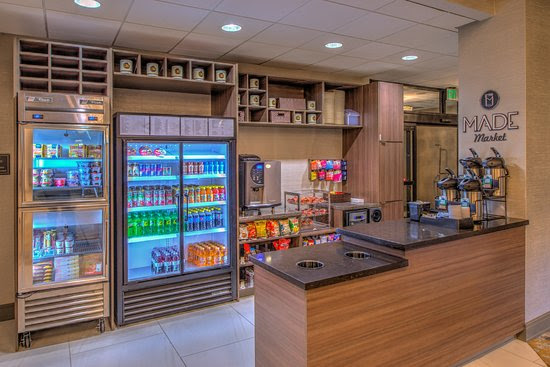
PLAINFIELD, IL, JULY 15, 2019 — Hotel pantries have long been discounted by owner/operators as oversized vending machines, essentially a guest amenity that they had neither the time nor the expertise to do right.
All that changed during the Great Recession when RevPAR plunged and owners sought new cash flows. At the same time, budget-conscious business travelers were spending less money on room service and fancy restaurant dining. Seeing an opportunity, astute hotel owners quickly recognized that a lobby “grab-and-go” market could generate profits while improving guest satisfaction.
“Hotel owners today understand that every square foot of a lobby is retail space that needs to provide a return on investment, and that pantries offer high margins on a small investment,” said Sam Cicero, Jr., president of Cicero’s Development Corp., a general contractor specializing in hospitality renovations.
According to Cicero, hotel owners who follow the lead of modern grocery stores in designing a pantry will profit. He gives the examples of Whole Foods and Trader Joe’s, which take great care in forging authentic atmospheres that encourage impulse buying. Reclaimed wood flooring, hand-crafted and quirky signage, local architectural details, and comfortable lighting universally appeal to shoppers. And he says, because a hotel pantry takes only a small fraction of the space of a grocery, adding top-notch retail elements can be done on a small budget.
Cicero offers these design tips to help hotel owners capture the full value of a lobby pantry project.
- LOCATION: Much like vending machines, a high-traffic area is best. If the pantry is tucked away in a corner where guests rarely pass through, sales will suffer and shoplifting becomes a concern. The ideal answer is to build-out a pantry space during a full lobby renovation, or to create a space by adding walls. However, an empty nook in your lobby or near the lounge may initially suffice.
- ADA COMPLIANCE: A person with a disability can experience access problems that non-disabled persons wouldn’t even necessarily think of when shopping. For example, people in wheelchairs have difficulty maneuvering in aisles when displays are placed in the middle of the aisle. Before beginning a pantry build-out consult with an ADA attorney or architect to ensure compliance.
- BRAND STANDARDS: Depending upon the extent of your pantry project, you may encounter some branding issues as you prepare for renovations to begin. If you run a franchise hotel, your franchisor will serve as a useful source of preliminary design requirements. If you have an independent hotel, you still need to check local codes that run the gamut from food safety to the provision of public facilities, labor laws, and other bureaucratic matters.
- SHELF MANAGEMENT: Drop-in shelving systems fit into most standard millwork, making them a cost-effective way to display products while maintaining organization of categories. Drop-in shelves permit vertical merchandising in neat rows. Adding spring-loaded push mechanisms maximize shelf space and keep the pantry looking fully-stocked down to the last item in a row.
- LIGHTING: Grid ceilings accommodate recessed LED troffers. This helps to create a seamless look that customers will appreciate. It will also help packaging colors pop, thus encouraging more customers to make an impulse purchase.
- FLOORING: In the lobby, flooring not only helps create an inviting, comfortable atmosphere, it defines key areas by using a range of colors and textures to transition from one space to another. Give the pantry its own distinctive visual style to separate it from the rest of the lobby. Because of the potential for liquids spilling, flooring slip resistance is important.
- ILLUSION OF SPACE: There is a fine line between cozy and cramped. Hotel pantries tend to be very small spaces and therefore present a number of unique challenges. Keep in mind the simple artist’s rule: cool colors recede and warm colors advance. So use light colors on the walls and fixtures. While white is the obvious choice, it isn’t the only option. Grays, light yellows and blues can be “hue-tastic.” Finally, if you choose tiles or wood for flooring, opt for wider planks as opposed to strip flooring. Place planks parallel to the longest wall of the room to expand the space visually.
For more information visit www.cicerosdev.com.


